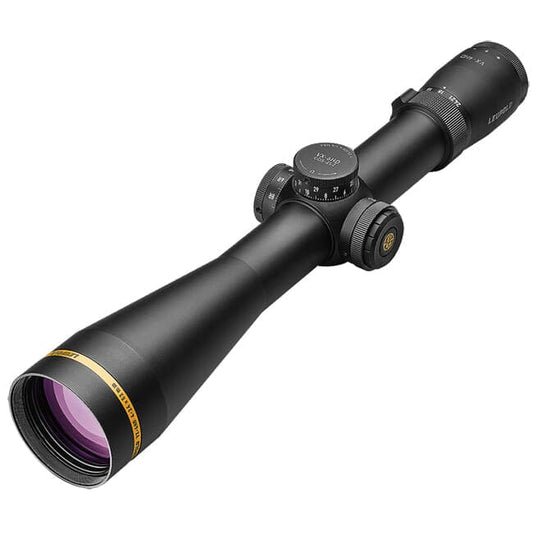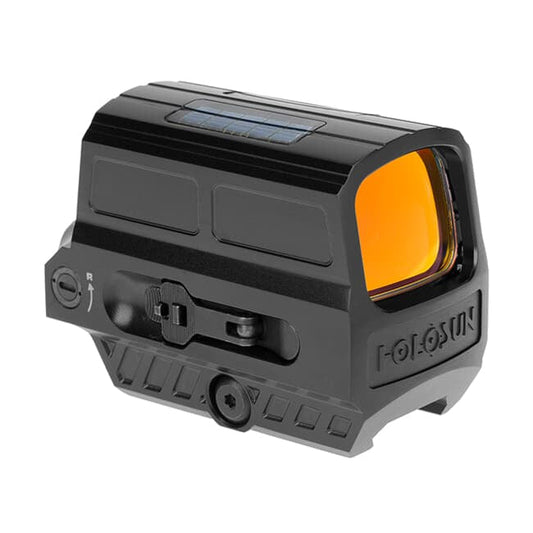What is MOA on a Red Dot Sight?
In the crosshairs of precision shooting, MOA on a red dot sight stands as a crucial element, yet it's often overlooked. Why does this seemingly small detail wield such influence over a marksman's accuracy? Understanding this concept is pivotal for anyone looking to improve their shooting proficiency.
MOA, or Minute of Angle, isn't just a measurement; it's the heartbeat of your red dot sight's accuracy. A red dot sight with a 1 MOA can pinpoint an area as small as one inch on a target 100 yards away, offering unmatched precision. Larger MOA dots offer quick target acquisition, making them ideal for rapid response scenarios.
But the intricacies of MOA extend beyond mere size. The right adjustment can mean the difference between a trophy and a story about the one that got away. As we delve deeper into the world of MOA, join us on a journey of discovery. Let's explore the precision that MOA brings to the table and learn to make every shot count.
What is MOA on a Red Dot Sight?
MOA, standing for Minute of Angle, is a critical factor in the accuracy of red dot sights. It's a unit of angular measurement, and it's as crucial to sharpshooters as the thread count is to a tailor. In the realm of red dots, MOA defines the size of the dot projected onto your target, which in turn, dictates how precise your aim can be.
But MOA isn't just about dot size. It's about the relationship between the sight and the target. With a standard MOA of one inch per hundred yards, this measurement tells you how much your bullet's point of impact will shift with each adjustment of the sight. A smaller MOA means a smaller dot, offering finer control for long-range accuracy.
Understanding MOA (Minutes of Angle)
MOA, the cornerstone of shooting accuracy, is often misunderstood. It's a mathematical expression of angular measurement that directly correlates to your sight's accuracy. Delving into MOA's fundamentals, we uncover how this minute angle is the secret to precision in shooting. Here's how it comes together:
- The Basics: MOA is an angular measurement. One MOA is exactly 1/60th of a degree. In shooting terms, this translates to one inch per hundred yards. Thus, a 1 MOA red dot will cover one inch of your target at 100 yards, two inches at 200 yards, and so on.
- MOA in Sights: On your red dot sight, MOA determines the size of the dot itself. A smaller MOA dot provides a more precise aim point, while a larger MOA dot might be quicker to acquire but less precise.
- Calculating Adjustments: Adjusting the MOA is like tuning an instrument—it's all about precision. For instance, a sight with 1/4 MOA adjustments will move the point of impact 1/4 inch per click at 100 yards.
Table: Typical MOA Sizes and Their Impact at Different Distances
| MOA Size | 100 Yards | 200 Yards | 300 Yards |
|---|---|---|---|
| 1 MOA | 1" | 2" | 3" |
| 2 MOA | 2" | 4" | 6" |
| 4 MOA | 4" | 8" | 12" |
The Significance of MOA in Red Dot Sights
The MOA's significance in red dot sights cannot be overstated. It's an essential component, integral to the sight's performance. This section will explore the pivotal role MOA plays in enhancing the efficacy of your red dot sight, affecting everything from shot accuracy to target acquisition speed. Here's why MOA is such a big deal:
- Impact on Shooting: Even a slight misunderstanding of MOA can be the difference between a hit and a miss. Knowing your MOA lets you make adjustments for range, wind, and elevation.
- Choosing the Right Dot: Depending on your shooting style, the size of the MOA dot on your red dot sight can affect your speed and accuracy. It's the difference between a scalpel and a broadsword—both are effective, but for different tasks.
- Real-World Application: Whether you're in a competition or in the field, the MOA of your red dot sight is a tool that adapts to your needs. It's a critical component of your shooting equation.
How MOA Affects the Performance of a Red Dot Sight
MOA's influence on a red dot sight's performance is profound. A proper understanding can be the difference between average and exceptional marksmanship. Here, we will dissect how MOA adjustments can fine-tune your aim and elevate your shooting prowess. Here's the role MOA plays:
- Accuracy and Precision: The MOA of your sight influences how accurately you can aim. A smaller MOA dot can pinpoint a more precise location on your target, while a larger MOA dot might be faster for the eye to pick up but could cover more of the target.
- Speed vs. Precision: Depending on your shooting discipline, you might prioritize speed over precision or vice versa. A 4 MOA dot is typically faster to acquire, making it suitable for close-quarter scenarios, whereas a 1 MOA dot offers more precision at the cost of acquisition speed.
- Adjusting for Distance: The further the target, the more critical MOA becomes. At longer ranges, a larger MOA dot could obscure your target, so understanding and adjusting your MOA appropriately is key to long-range shooting success.
Choosing the Right MOA Size for Your Needs
Selecting the right MOA size is crucial for your red dot sight. It's about matching your equipment to your shooting style and goals. This section provides insight into tailoring the MOA size to your unique needs, ensuring your sight complements rather than compromises your shooting. Here's how to decide:
- Your Shooting Style: Are you quick on the draw, or do you take time to line up each shot? Your shooting style will determine whether a larger or smaller MOA dot is right for you.
- Your Targets: The size of your targets and the distances you're shooting at are crucial considerations. A 2 MOA dot is a versatile choice, providing a balance between speed and precision.
- Trial and Error: There's no substitute for experience. Trying out different MOA sizes will help you find the sweet spot for your particular needs
Adjusting MOA Settings on Your Red Dot Sight
Mastering MOA adjustments on your red dot sight is akin to a musician tuning their instrument. It requires finesse and understanding. We'll guide you through the process, ensuring you can make those critical adjustments that count in the field.
Here's how to get there:
- Understanding Your Sight: Familiarize yourself with the adjustment knobs. They control the vertical and horizontal movement of the dot, allowing you to dial in your aim precisely.
- Click Value: Each click of the knob usually equals a 1/4 MOA adjustment. At 100 yards, that's about a quarter-inch movement. This standard measurement helps you calculate the needed adjustments without guesswork.
- Range Time: Spend time at the range to practice adjusting your MOA. The more you practice, the more intuitive these adjustments will become.
Recommended Red Dot Sights with Specific MOA Measurements
Choosing a red dot sight with the right MOA setting is a pivotal decision for any shooter. This section will spotlight top-tier red dot sights, highlighting their specific MOA attributes and how they cater to diverse shooting demands. Here's a guide to help you pick:
- For Precision Shooters: A sight with a 1 MOA dot is perfect for those who require pinpoint accuracy.
- For Speed Demons: If quick target acquisition is your priority, look for a sight with a larger MOA, like 4 MOA.
- For the All-Rounders: A 2 MOA red dot sight strikes a balance between speed and precision, making it a great all-purpose option.
Common Misconceptions About MOA on Red Dot Sights
In the realm of sharpshooting, a red dot sight is your trusty guide, and MOA is your language of precision. Yet, amidst the circles of shooters, several myths about MOA persist, muddling the waters of clarity. Let's demystify these common misconceptions about MOA on red dot sights, ensuring your knowledge is as precise as your aim. Here are five widespread myths that need to be unpacked and corrected for the betterment of marksmen everywhere.
-
MOA is the same at all distances: Some believe that 1 MOA always equals 1 inch regardless of distance, which is incorrect. MOA is an angular measurement, and the size it represents increases proportionally with distance.
-
Smaller MOA dots are always better: While smaller MOA dots provide greater precision, they may not be the best choice for every situation. For close-range or fast target acquisition, a larger MOA dot could be more beneficial.
-
MOA adjustments are universal: The belief that all red dot sights adjust in the same MOA increments is false. Different sights have different adjustment values per click, which can vary from 1/4 MOA to 1 MOA or more.
-
MOA size affects the brightness of the dot: There's a misconception that the MOA size of the dot affects its brightness. MOA refers to the size of the dot, not its luminosity, which is controlled by a separate setting on the sight.
-
Higher MOA equals less accuracy: A larger MOA doesn't mean less accuracy; it means the dot covers a larger area on the target, which can be an advantage in certain shooting scenarios. The precision comes down to how well the shooter can use the sight in conjunction with their shooting skills.
Tips for Using MOA on Red Dot Sights
Effective use of MOA on red dot sights requires more than just understanding; it demands practical tips and tricks. Here, we'll offer actionable advice to help you harness the full potential of MOA in your shooting endeavors.
- Start at a Standard Distance: Begin your MOA adjustments at 100 yards to establish a baseline.
- Keep a Log: Record your adjustments and the resulting impacts. This log will become an invaluable reference over time.
- Trust Your Instincts: Use the MOA dot as a guide, but remember, your instincts play a big role in shooting accurately.
Conclusion: Mastering MOA on Red Dot Sights
Embracing MOA is about unlocking a higher level of precision in your shooting. It's not a mere technicality; it's the fine line between a miss and a moment of triumph. When you understand MOA, you're not just shooting; you're crafting every shot with the expertise of a marksman who knows their tools inside out.







